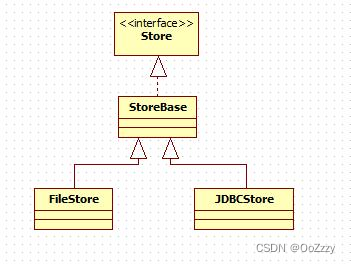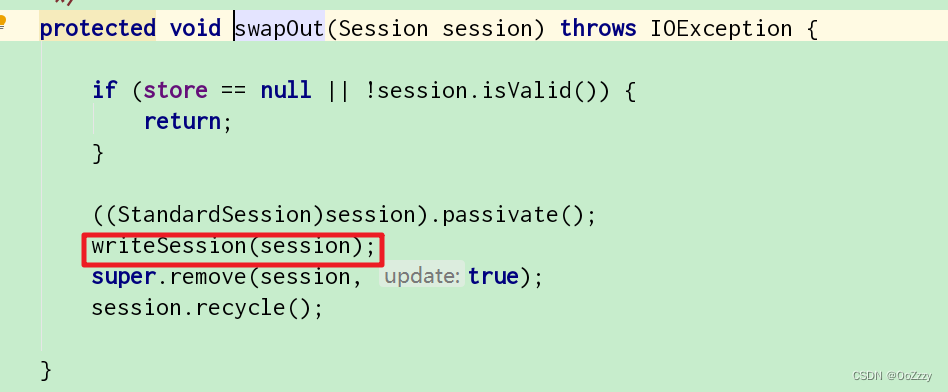-
Tomcat 源码分析 (Tomcat的Session管理之管理持久化Session) (十三)
1.前记

-
PersistentManagerBase
Session管理器中打标持久化Session的父类, 虽然StandardManager也可以将Session持久化,但是只是将Session持久化为一个文件,PersistentManagerBase类和StandardManager类的区别在于前者的存储器的表现形式可以有多种,比如数据库,文件等。 -
PersistentManager
在PersistentManagerBase基础上增加了两个属性。
2.持久化Session管理
PersistentManager代表的是持久化session的管理器,PersistentManager类定义中有个变量org.apache.catalina.Store, 该变量表示session管理器持久化session的方式
-
Store
持久化存储方式的抽象类,定义了一些基本方法,例如save(),load(),keys(),clear()等。save()用来将session持久化到持久性介质中。load()方法从持久化介质中读取到内存中,keys()则返回所有的sessionId数组。clear()则清除所有的session。 -
StoreBase
抽象类,对Store作了基本实现。 -
FileStore
该类会将session对象存储到某个文件中,文件名会使用session对象的标识符再加上一个后缀.session构成。文件位于临时目录下,也可以调用FileStore类的setDirectroy()方法修改目录。 -
JDBCStore
该类将session对象通过jdbc存入数据库,因此使用该类需要使用jdbc链接。
Request的doGetSession()方法中,我们之前默认manager实现类是StandardManager,如果tomcat中配置的是PersistentManager,那么manager.findSession(requestedSessionId)会略有不同manager.findSession(requestedSessionId)@Override public Session findSession(String id) throws IOException { //调用父类的findSession() 也就是ManagerBase类中的findSession,从现有内存中查找是否有指定的session Session session = super.findSession(id); // 代码运行到这里,因为我们不确定是否有别的线程要移除这个session,所以最保险的办法就是加锁再次尝试获取该session // 如果有其他代码正在执行 swapOut(将内存session持久化到介质中),那么我们应该返回null,如果没有的话,那么我们就可以安全的访问这个session if(session != null) { synchronized(session){ session = super.findSession(session.getIdInternal()); if(session != null){ // To keep any external calling code from messing up the // concurrency. session.access(); session.endAccess(); } } } // 再次判断 if (session != null) return session; // See if the Session is in the Store //从持久化介质中查找 session是否存在 session = swapIn(id); return session; }- 1
- 2
- 3
- 4
- 5
- 6
- 7
- 8
- 9
- 10
- 11
- 12
- 13
- 14
- 15
- 16
- 17
- 18
- 19
- 20
- 21
- 22
- 23
- 24
- 25
- 26
- 27
swapIn()从持久化介质中查找 session是否存在
protected Session swapIn(String id) throws IOException { if (store == null) return null; Object swapInLock = null; /* * The purpose of this sync and these locks is to make sure that a * session is only loaded once. It doesn't matter if the lock is removed * and then another thread enters this method and tries to load the same * session. That thread will re-create a swapIn lock for that session, * quickly find that the session is already in sessions, use it and * carry on. */ synchronized (this) { swapInLock = sessionSwapInLocks.get(id); if (swapInLock == null) { swapInLock = new Object(); sessionSwapInLocks.put(id, swapInLock); } } Session session = null; synchronized (swapInLock) { // First check to see if another thread has loaded the session into // the manager session = sessions.get(id); if (session == null) { try { if (SecurityUtil.isPackageProtectionEnabled()){ try { session = AccessController.doPrivileged( new PrivilegedStoreLoad(id)); } catch (PrivilegedActionException ex) { Exception e = ex.getException(); log.error(sm.getString( "persistentManager.swapInException", id), e); if (e instanceof IOException){ throw (IOException)e; } else if (e instanceof ClassNotFoundException) { throw (ClassNotFoundException)e; } } } else { //加载session //1111111 session = store.load(id); } } catch (ClassNotFoundException e) { String msg = sm.getString( "persistentManager.deserializeError", id); log.error(msg, e); throw new IllegalStateException(msg, e); } if (session != null && !session.isValid()) { log.error(sm.getString( "persistentManager.swapInInvalid", id)); session.expire(); removeSession(id); session = null; } if (session != null) { if(log.isDebugEnabled()) log.debug(sm.getString("persistentManager.swapIn", id)); session.setManager(this); // make sure the listeners know about it. ((StandardSession)session).tellNew(); add(session); ((StandardSession)session).activate(); // endAccess() to ensure timeouts happen correctly. // access() to keep access count correct or it will end up // negative session.access(); session.endAccess(); } } } // Make sure the lock is removed synchronized (this) { sessionSwapInLocks.remove(id); } return session; }- 1
- 2
- 3
- 4
- 5
- 6
- 7
- 8
- 9
- 10
- 11
- 12
- 13
- 14
- 15
- 16
- 17
- 18
- 19
- 20
- 21
- 22
- 23
- 24
- 25
- 26
- 27
- 28
- 29
- 30
- 31
- 32
- 33
- 34
- 35
- 36
- 37
- 38
- 39
- 40
- 41
- 42
- 43
- 44
- 45
- 46
- 47
- 48
- 49
- 50
- 51
- 52
- 53
- 54
- 55
- 56
- 57
- 58
- 59
- 60
- 61
- 62
- 63
- 64
- 65
- 66
- 67
- 68
- 69
- 70
- 71
- 72
- 73
- 74
- 75
- 76
- 77
- 78
- 79
- 80
- 81
- 82
- 83
- 84
- 85
- 86
- 87
- 88
- 89
- 90
- 91
- 在Store(存储介质)中查找session,如果发现将把session恢复到该Manager的活跃session集合中。
- 这个session将会从Store中移除,但是如果session过期或者无效将不会添加到活跃集合。
Store.load(id)
- FileStore
- JDBCStore
Store.save()ManagerBase.backgroundProcess()@Override public void backgroundProcess() { count = (count + 1) % processExpiresFrequency; if (count == 0) processExpires(); }- 1
- 2
- 3
- 4
- 5
- 6
模板方法模式, 子类拓展
processExpiresPersistentManagerBase.processExpires()
public void processPersistenceChecks() { processMaxIdleSwaps(); processMaxActiveSwaps(); processMaxIdleBackups(); }- 1
- 2
- 3
- 4
- 5
- 6
- 7
processMaxIdleSwaps()调用swapOut()
writeSession()调用的是Store.save()
processMaxActiveSwaps(),processMaxIdleBackups()方法类似PersistentManager与StandardManager区别在于,PersistentManager在StandardManager的基础上额外增加了存储的功能,不管查找,删除,还是保存都需要在内存和存储器中同时进行。3.xml文件中配置
在web.xml中配置 session 的过期时间,默认30min
<session-config> <session-timeout>30session-timeout> session-config>- 1
- 2
- 3
在server.xml中配置 session管理器,默认
StandardManager可以不配置,如果需要配置全局的session manager,可以在conf/context.xml中配置1. StandardManager
当Tomcat服务器关闭或重启,或者Web应用被重新加载时,会对在内存中的
HttpSession对象进行持久化, 并把它们保存到文件系统中,默认的文件为$CATALINA_HOME/work/Catalina/hostname/applicationname/SESSIONS.server- 1
2. PersistenManager
<Manager className="org.apache.catalina.session.PersistentManager" saveOnRestart="true" maxActiveSessions="-1" minIdleSwap="60" maxIdleSwap="60" maxIdleBackup="60" > <Store className="org.apache.catalina.session.JDBCStore" driverName="com.mysql.jdbc.Driver" connectionURL="jdbc:mysql://url?user=user&password=psd" sessionTable="tomcat_session" sessionIdCol="session_id" sessionDataCol="session_data" sessionValidCol="session_valid" sessionMaxInactiveCol="max_inactive" sessionLastAccessedCol="last_access" sessionAppCol="app_name" /> Manager>- 1
- 2
- 3
- 4
- 5
- 6
- 7
- 8
- 9
- 10
- 11
- 12
- 13
- 14
- 15
- 16
- 17
- 18
- 19
- 20
- 21
saveOnRestart:是否在重启的时候加载保存sessionmaxActiveSessions:最大允许session数量,-1 不限制minIdleSwap:最小空闲时间,超出将会被转存到存储器中maxIdleSwap:最大空闲时间,超出将会被转存到存储器中
Store相关:
directory:采用FileStore的时候指存储session的目录sessionTable:存储session的表名sessionIdCol:sessionid列名sessionDataCol:sessionData列名sessionValidCol:session是否有效列名sessionMaxInactiveCol:session最大闲置时间列名sessionLastAccessedCol:session上次访问时间列名sessionAppCol:session归属的应用名称列名
-
-
相关阅读:
e签宝,再「进化」
深入浅出Java多线程(四):线程状态
Spring 统一处理(JavaEE进阶系列6)
重磅!OpenAI发布GPT-4o,非常惊艳语音版ChatGPT!
Spring Retry 重试
Python: 你所不知道的星号 * 用法
JVM垃圾收集器总结
GitLab 内存、cpu资源占用过大问题解决
基于Flask创建Python服务端,并调用JavaScript客户端
微信小程序地理位置接口使用流程
- 原文地址:https://blog.csdn.net/qq_43141726/article/details/126120337
